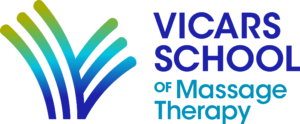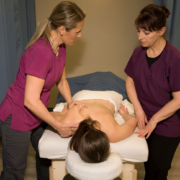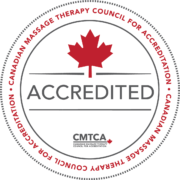Your Most “Pressing” Massage Therapy Questions, Answered!
Making an appointment for a therapeutic massage treatment from a professional RMT is one of the greatest gifts you can give yourself. Massage therapy has proven benefits for your physical and mental health. If you’ve never had a professional massage before, though, it can also be a daunting prospect!
To help you prepare for your first massage—or maybe give you the confidence boost you need to pick up the phone and make an appointment—we’ve created this cheat sheet. It’s based on some of the most frequently asked questions that we receive from new clients at our student massage clinics in Edmonton and Calgary.
How long is a massage? How much time will the appointment take?
Most massage therapy treatments are 60 minutes, though some RMTs will offer 30-minute, 45-minute, or 90-minute treatments.
But regardless of the treatment length, the actual appointment will take longer than that. That’s because there’s more to a massage therapy appointment than just the time you spend on the table.
The steps of a typical therapeutic massage appointment are:
- Filling out a health history form and any other new-client paperwork
- Interview and assessment. Before you get on the table, your massage therapist should check in with you about your goals for the session, review your health history, and discuss their treatment plan, and get your consent for the massage. Depending on your needs, they may perform a non-invasive physical assessment. They might assess your posture or gait, test your range of motion, or palpate (gently touch) parts of your body.
- The massage itself. The best part!
- Homecare consultation. After you’ve gotten dressed and are off the table, your RMT will give you personalized advice on how to maintain the benefits of your treatment. They may show you some stretches or simple exercises, or even self-massage techniques that you can use at home.
- Payment and rebooking.
To help you plan out your day, ask about the length of the appointment when you’re booking.
Can I keep my clothes on during the massage?
If you want to!
Before you get on the table, your massage therapist will explain what areas of your body they’re going to treat that day. They will ask you to undress to your level of comfort, and then leave the room while you undress and get under the sheet or blanket. Most people take off all their clothes, or leave on only underwear, but it’s up to you. It’s your massage!
Of course, any clothes you’re wearing will impact your massage experience. Your massage therapist may not be able to perform some techniques through fabric, or the techniques may not be as effective.
If you plan to leave your clothes on over an area of your body that is going to be massaged, it’s a good idea to mention this to your RMT during the interview. That will allow them to adapt their treatment plan to meet your needs.
Please keep in mind that any clothes that you wear during the massage may come in contact with the massage lotion, oil, or gel that your RMT is using. These products can also transfer to your other clothes when you get dressed after the massage, so it’s best to wear casual, machine-washable clothes to your appointment.
Will my body be covered during the massage?
Yes! When you are on the massage table, you will stay covered by a sheet, towel, or blanket. Your RMT will only uncover the area of the body that they’re currently working on. The rest of your body will remain securely covered. Extra care is taken to shield your body when you turn over, and when draping around sensitive areas like your glutes, chest, and abdomen.
If you get cold during your massage, mention this your therapist. They can provide extra blankets or even give you a heating pad.
How do I choose a massage therapist in my community?
There are lots of great massage therapists out there but finding the right RMT for you takes more than a quick Google search.
It’s worth taking a few minutes to do some simple research before you book an appointment with a professional massage therapist. Start by thinking about what your goals are for the massage. Do you want a relaxation massage, or are you looking for a treatment that will target a specific issue like TMJD, back pain, scoliosis, or arthritis? Do you want to combine your massage treatment with other therapeutic modalities like cupping or manual lymphatic drainage? What’s your budget? Do you have insurance coverage?
Once you have a little bit more of an idea of what you’re looking for, it’s time to start your search.
The best way to find the right RMT for you is to ask around! Ask your friends and family if they have a therapist they like (and why). Other health care professionals can also be great sources of recommendations. Many physiotherapists, chiropractors, and even family doctors have a list of RMTs and clinics that they regularly refer their patients to.
You can also search the therapist directories of your province’s professional associations or regulatory college, such as the MTAA and NHPC in Alberta, and the CMTBC in British Columbia. These directories usually let you search by name or location, which is very convenient.
It’s important that any massage therapist you visit is qualified and licensed or registered in your province, and checking with a provincial college or association is a good way to make sure your RMT meets the minimum training standards required where you live.
If you live in Alberta, Saskatchewan, or another province where massage therapy (and massage therapy education) aren’t standardized and regulated by the government, it’s important to ask your RMT where they went to school.
Of course, we recommend finding a Vicars therapist! But if you’re not lucky enough to have one of our grads in your community (or if they’re simply too busy to take on new clients), try to find an RMT who was trained at a CMTCA Accredited program, or a college on the MTAA Approved Schools list.
If you live in Calgary or Edmonton, give one of our teaching clinics a try! Your therapist will be a first- or second-year massage student, and there is a Vicars faculty supervisor there to support them. Some of our regular clients visit our clinic in between appointments with their fully trained RMT, but the student clinics are also a great way for beginners to give massage a try for a lower price than a traditional clinic.
Wherever you go, we hope you enjoy your massage—we’re sure it will be the first of many!



